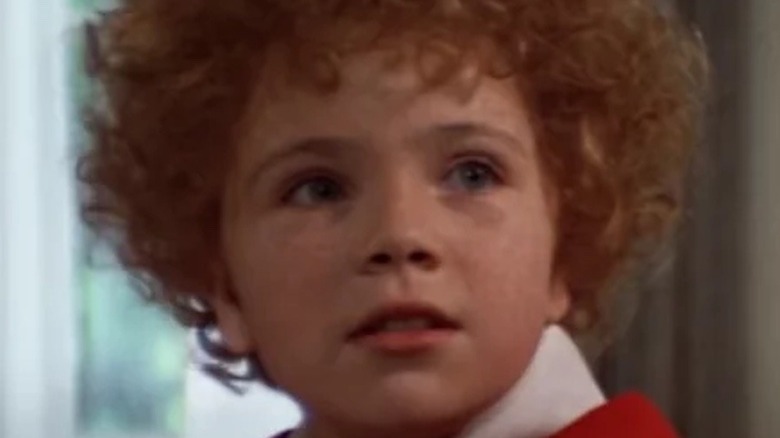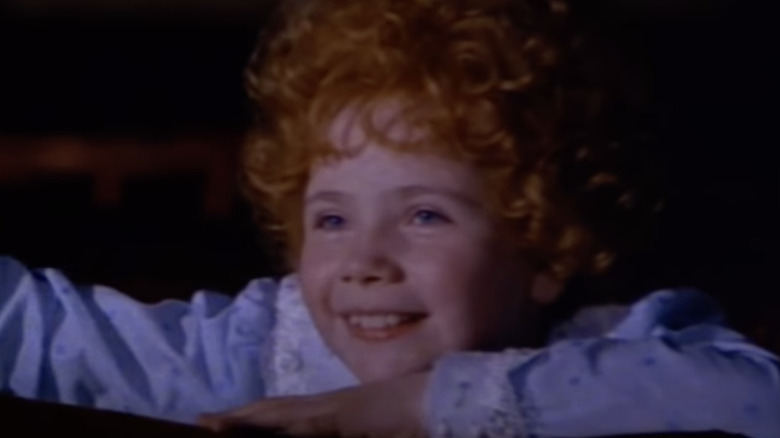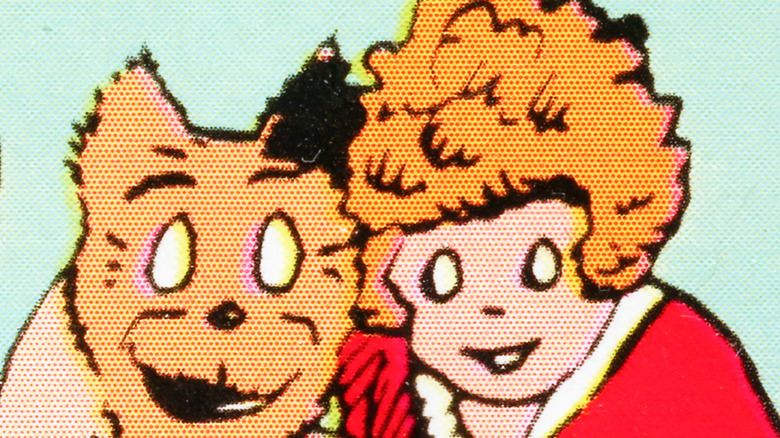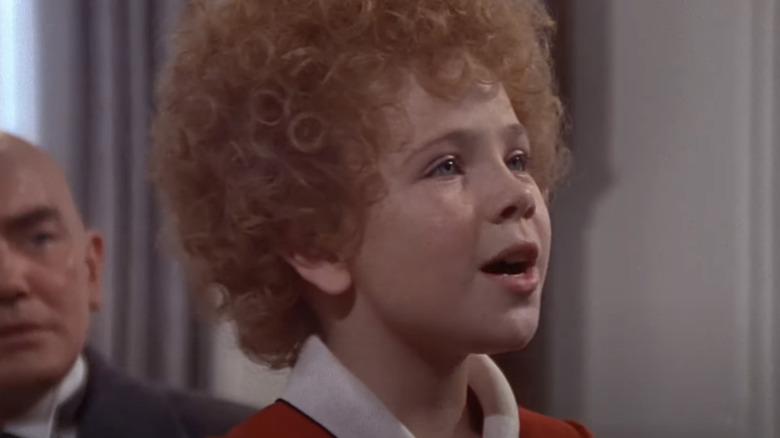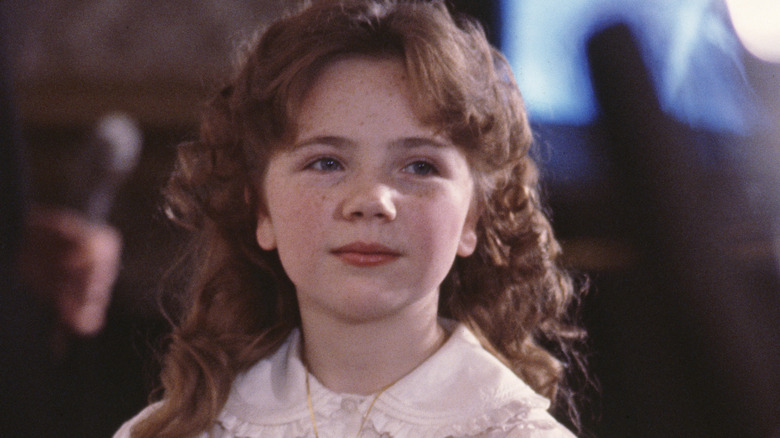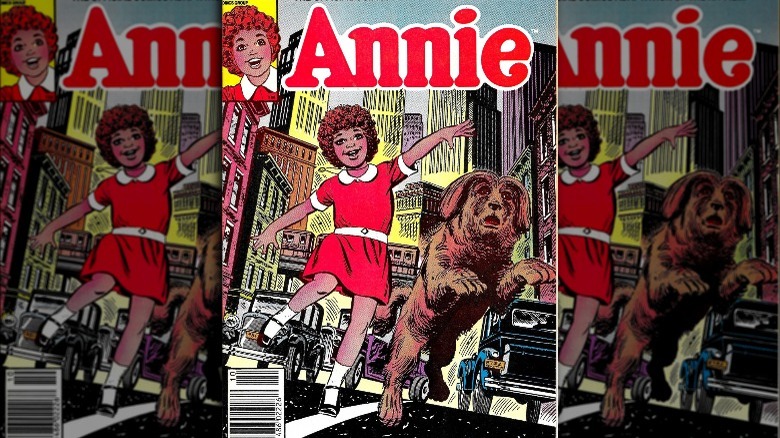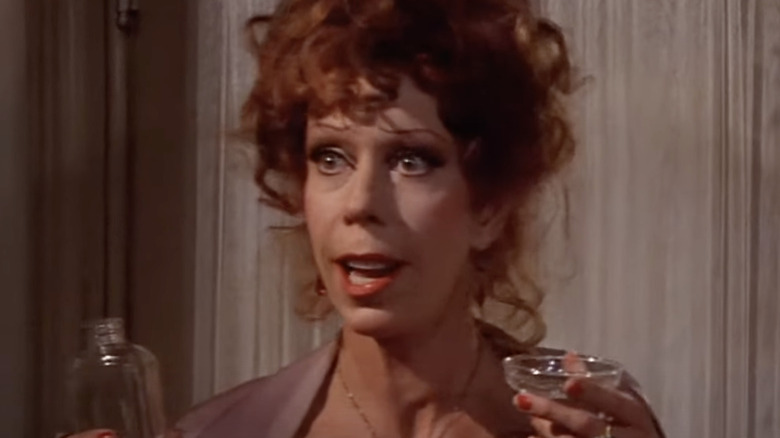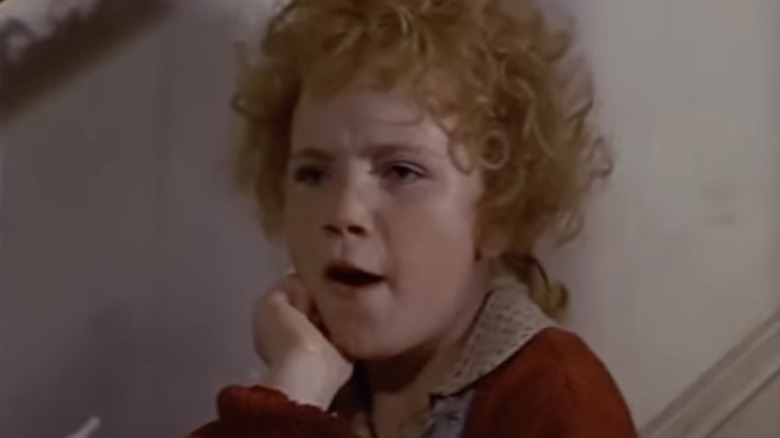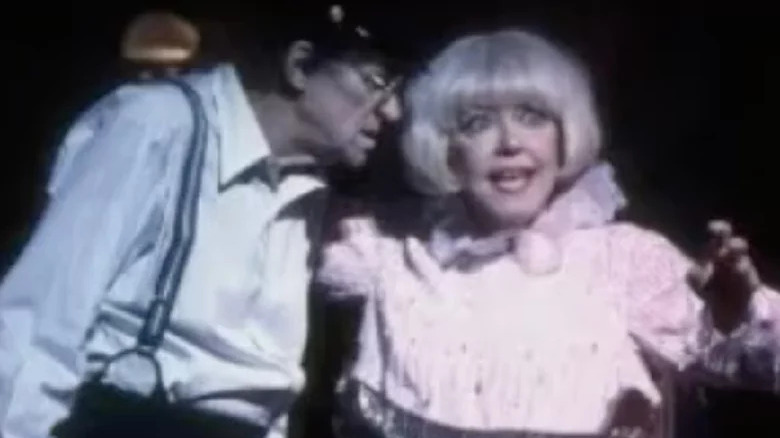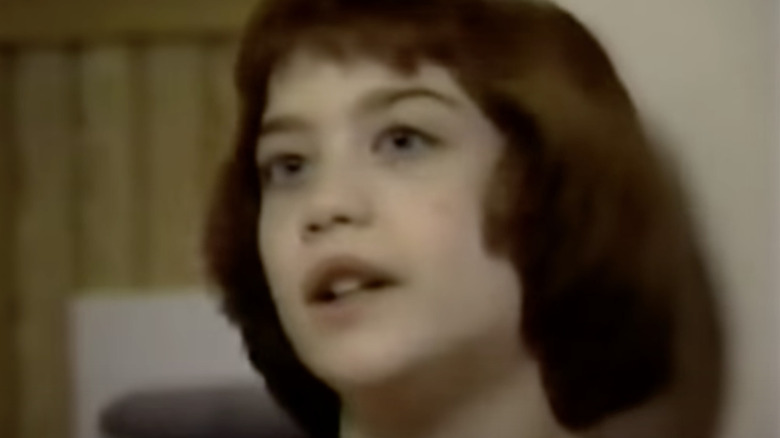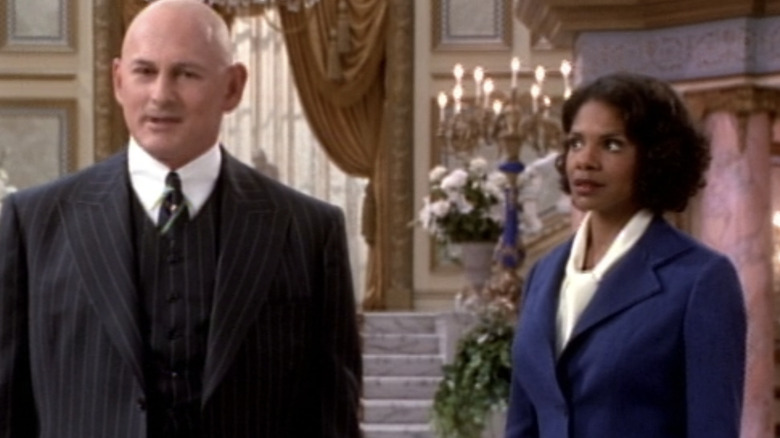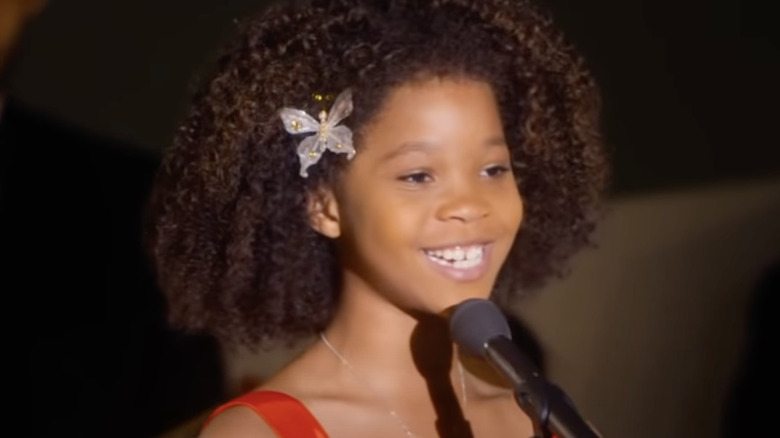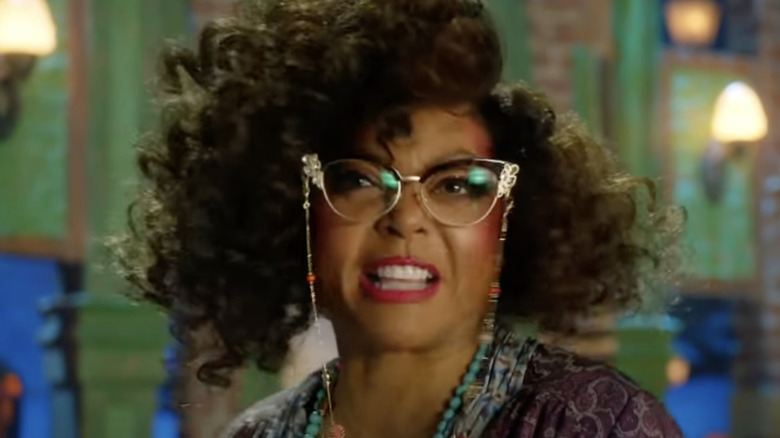The Untold Truth Of Annie
We may receive a commission on purchases made from links.
People embrace some kinds of entertainment when they're young and never let them go — they'll unabashedly follow and consume everything related to their favorite comic strip character, Broadway musical, or classic kiddie movie, for example. Annie, or Little Orphan Annie, or Annie Warbucks, the plucky, relentlessly optimistic, Depression-era orphan turned adopted rich girl has been a smash hit and landmark character in comic strips, musicals, movies, and plenty of other venues. Probably the definitive image of Annie to young and old, and of multiple generations: child actor Aileen Quinn as the character in her curly red hair and bright red dress in the enduring, 1982 film version of the 1970s stage musical.
"Annie" has a long, and surprisingly complicated and dramatic history. Bet your bottom dollar that this is everything you've ever wanted to know about Annie in all of her appearances across all kinds of media over the past century. Leapin' lizards, you're only a read away from the untold truth of (little orphan) Annie.
The original Annie was named Otto
Annie made a splash in full-color, full-sound movies, but the character was a pop culture franchise and phenomenon years before either of those mediums even existed. According to the National Women's History Museum, Harold Gray ran a commercial art business in Chicago in the 1920s, and assisted cartoonist Sidney Smith, author of the comic strip "The Gump." Inspired to create his own cartoon, Gray came up with the idea of a boy who could do whatever he wanted and go wherever he pleased, because he was an orphan and thus free of any familial or social commitments.
Gray named the strip "Little Orphan Otto," but when he pitched it to distributor the Chicago Tribune Syndicate (per Britannica), an editor suggested he make the lead character female (as the vast majority of strips at the time were about boys). According to the Indiana State Library, Gray changed Otto to Annie, as suggested by "Little Orphant Annie," a popular poem of the 1880s by James Whitcomb Riley. That four-stanza work is about a parentless girl taken in by a large family, and she tirelessly does chores to "earn her board-an-keep" and tells the children a spooky story about how if they're not careful, "the Gobble-uns'll git you." "Little Orphant Annie" was so well-known that it was adapted into musical compositions and a 1918 silent film.
'Little Orphan Annie' ran for almost 90 years
The "Little Orphan Annie" comic strip debuted in newspapers on August 5, 1924, starring resilient and crafty street urchin Annie, who notably lacked pupils in her all-white eyeballs. The strip became so widely read so quickly that in 1930, it was adapted for radio by Chicago station WGN, the first time a national scripted show featured a child as the primary character. Per the Radio Hall of Fame, the show moved to the NBC Blue network in 1931, where it ran until 1942, and just like in the comic, Annie, dog Sandy, and friend Joe traveled around the world, defeated gangsters and other criminals, and checked in occasionally with Annie's benefactor and father figure, the appropriately named Oliver "Daddy" Warbucks, who amassed his fortune as a war profiteer during World War I.
"Little Orphan Annie" creator Harold Gray died in 1968, but his strip continued on with other artists and writers for decades, wrapping up an 86-year-run in 2010, when syndicator Tribune Media Services decided to end it, according to the New York Daily News. By that point, the strip appeared in fewer than 20 newspapers. Even after all that time, "Little Orphan Annie" ended on a cliffhanger. Annie was kidnapped by a war criminal, a plot that was finally resolved four years later in another long-running Tribune strip: Tough-guy detective Dick Tracy of "Dick Tracy" rescues Annie, per CBR.
'Tomorrow' has a lot of past
The signature song of the whole "Annie" franchise and used in most every performative take on the character is "Tomorrow," an American standard that became one of the best known show tunes of all time. It's lyrics about hope and cheerfulness ("the sun'll come up tomorrow / bet your bottom dollar that tomorrow / there'll be sun") perfectly encapsulate Annie the character and sum up "Annie" the musical. And yet, that musical marked the third time that composer Charles Strouse tried to use it. In 1970, he wrote the music and lyrics for a song called "The Way We Live Now" for a short film about deja vu called "Replay." A few years later, Strouse would keep the melody of the song but have collaborator Martin Charnin come up with new lyrics to create "Tomorrow" for their musical version of the "Little Orphan Annie" comic strip.
According to the Washington Post, "Annie" endured a lengthy, rocky road to Broadway in the 1970s, and when it seemed like the show may never open, Strouse placed a once again revised version of "Tomorrow" into another show he was working on at the time, "Charlie and Algernon," a musical based on the novel "Flowers for Algernon," about a developmentally disabled man temporarily made into a super-genius with science. But then "Annie" picked back up, and Strouse cut the song from "Charlie and Algernon."
Casting the Annie movie proved tough
According to the New York Times, "Annie" cost Columbia Pictures as much as $50 million to make, so it was very important that the studio find just the right people to play the roles in the film version of the popular musical. Producers held a protracted audition process, spending a year holding events in 22 cities in the United States, Canada, and Europe in search of the perfect Annie. Casting agent Garrison True reviewed around 9,000 individual auditions, thought 522 young actors were good enough to make a 15-minute audition tape, and from there, gave the plum role to 10-year-old Aileen Quinn, who had little experience besides some TV commercials and as one of Annie's fellow orphans in the Broadway run of "Annie."
Filmmakers didn't get their first choices for some of the adult roles in "Annie." According to "Casting Might-Have-Beens," Sean Connery went so far as to take singing lessons to get ready to portray Daddy Warbucks, but pulled himself out of the running before filming began. Bette Midler turned down the chance to play mean orphanage director Miss Hannigan (leaving the role to Carol Burnett), while Tim Curry got the role of Hannigan's scamming brother Rooster after Mick Jagger (per "Mick") refused a $2 million offer.
The Annie merchandising push was weird
Big, expensive movies tend to arrive with massive merchandising campaigns. Selling swag associated with the film serves as promotion while also helping to recoup the tremendous costs of making the thing and elevating the project from mere movie to an event of pop culture-saturating proportions. The merchandising campaign for "Annie" was one of the most vast and ambitious in Hollywood history to that point. According to The New York Times, more than 50 companies landed licensing deals to make a grand total of more than 500 "Annie" items, including red wigs so kids could look like Aileen Quinn, dog toys bearing the image of Annie's dog Sandy, umbrellas, and a board game. There were some other pieces of merchandise on the odder side, such as "Annie" ice cream, expensive designer jeans bearing the name of the titular homeless orphan, and Annie porcelain dolls and rag dolls — like the ones that might have been popular around the time of the movie's 1930s setting.
The "Annie" film was also translated into print media, in the form of a comic book series by Marvel, an imprint that usually published stories about superheroes and space aliens. In the U.K., it was published as a classy, hardbound book.
The film only looked like a hit on paper
The popularity of "Annie" on the funny pages and the Broadway stage translated to the box office. According to Box Office Mojo, "Annie" was a big summer hit, raking in $57 million and ranking as the 12th-highest grosser of the year (out-earning era classics like "First Blood," "Conan the Barbarian," and "Tootsie"). Its presumed and eventual success for Columbia Pictures prompted other studios to release their own movie versions of Broadway hits, and the early '80s were a boom period for musicals because of "Annie." According to "Fiasco: A History of Hollywood's Iconic Flops," Paramount made a "Popeye" musical starring Robin Williams after losing a bidding war for the "Annie" rights. Meanwhile, Universal produced "The Best Little Whorehouse in Texas," which edged out the box office haul of "Annie."
According to "The Oxford Handbook of Musical Theatre Screen Adaptation," "Annie" was, at the time of its production, the most expensive movie musical ever made. Per the New York Times, it's total budget fell somewhere between $40 million and $50 million, about four times that of 1982's biggest box office hit, "E.T.: The Extra-Terrestrial." The unfortunate result: Despite the success of "Annie," it was such a costly production that it actually lost money for Columbia Pictures.
Her creators didn't care for the Annie movie
According to the Hartford Courant, "Annie" made millions in its Broadway run, prompting a sale of the movie rights for $9.5 million — a record for a Broadway show at the time. That led to a loss of authority over "Annie" for its creative team, lyricist and director Martin Charnin said, which means he very much did not care for the popular 1982 "Annie" film. "The movie distorted what this musical was. And we were culpable for the reason that we did not exercise any kind of creative control because we sold the rights for a considerable amount of money." Charnin singled out for derision Albert Finney's performance of Daddy Warbucks ("an Englishman who screamed"), Carol Burnett's work as Miss Hannigan ("a man-crazy drunk") and even Aileen Quinn's Annie ("cute-ed up"). The lyricist also took umbrage with how he feels the movie didn't properly feature the song "Tomorrow," because he heard that producer Ray Stark "thought it was corny."
Oddly, this echoes the attitude some of Charnin's cohorts had when he pitched them on the idea of an "Annie" live musical back in the early 1970s. According to the New York Times, scriptwriter Thomas Meehan and composer Charles Strouse were initially extremely averse to the idea of making a show out of a comic strip (as had been done with "Li'l Abner"), but got on board when Charnin envisioned a musical "inspired" by "Little Orphan Annie," not based upon it.
The Annie stage sequel was a disaster
Movie sequels are ubiquitous and profitable, but continuations of popular stage musicals almost always bomb. Case in point: Flops like "Bring Back Birdie" (a sequel to "Bye Bye Birdie"), "The Best Little Whorehouse Goes Public" (successor to "The Best Little Whorehouse in Texas"), and "Annie 2: Miss Hannigan's Revenge." According to the New York Times, Martin Charnin, director and lyricist for "Annie," announced in 1982 (around the time "Annie" the movie opened) that a stage sequel was in the works and would hit Broadway in 1983. It took seven years for the project to get off the ground and for all the right people to agree to come back, including original Miss Hannigan Dorothy Loudon, scriptwriter Thomas Meehan, and composer Charles Strouse. After many public audition events, Charnin selected 11-year-old Missouri actor Danielle Findley to play Annie, and her face appeared on the cover of Life magazine.
"Annie 2" went before audiences in Washington D.C., on December 22, 1989, and the audience didn't like the 3.5-hour show. The run of performances had been delayed by a week due to technical issues, and then when it did open, critics almost universally savaged it. Producers, who had already spent $7 million on "Annie 2," delayed a planned Broadway opening by months — and it ultimately didn't happen at all. Undeterred, Charnin workshopped and revised the show into a new project called "Annie Warbucks," per the New York Times, which toured major American cities in 1992 (but never played Broadway).
The Annie revival made its original star cry
"Annie" opened on Broadway in April 1977 and ran for 2,377 performances over nearly seven years, making it one of the most successful shows in New York theatrical history (per Playbill). That's the kind of show that's prime for a revival, and the first eventful, heavily promoted return to Broadway for "Annie" came when the show was booked into the Martin Beck Theatre in March 1997 to commemorate its 20th anniversary. The squeaky-clean, family-friendly, widely loved musical wasn't without scandal, somehow.
According to Playbill, 12-year-old Joanna Pacitti, who played the title role in a touring production from November 1996 to February 1997, was set to star in the Broadway version, too. Just before the show went live, however, producers fired Pacitti and promoted her understudy, 8-year-old Brittny Kissinger. Pacitti reacted and emoted on TV. "It split my heart in two," Pacitti said of the firing on ABC's "Good Morning America," adding that her parents planned to sue "Annie" organizers for as much as $50 million. "I'm a lot like Annie `cause I keep my chin up," Pacitti added, through tears on ABC's "Turning Point." "Out of a hundred shows or more, I've got a standing ovation every single time, and if you went to the six cities that I went to, I think that they'll remember me as the real Annie." According to the New York Post, the case was settled out of court for a few million dollars, in 2001.
The 1999 production of Annie offended TV executives
Audra McDonald is a Broadway legend. In 2014, she won a record sixth Tony Award (per Playbill) and she's the only person to win in all four acting categories. She brought her musical cred to TV in 1999, playing Grace Farrell in ABC's "Wonderful World of Disney" presentation of "Annie." Grace is the third main character in "Annie," behind Annie and Daddy Warbucks (Victor Garber), to whom she serves as a mother figure and love interest, respectively. It's the latter element that reportedly made some executives uncomfortable.
"We shot the scene where Daddy Warbucks gives Grace Farrell the ring, and it's lovely," McDonald told WNYC's "Here's the Thing" in 2017. And then, the cast had to report back to the set some time later for reshoots of the scene. "They took me aside and said 'it turns out that Disney might be a little uncomfortable,' or the powers that be, I don't know if it was Disney or ABC, I don't know, 'there might be some issues with Daddy Warbucks actually marrying Grace.'" McDonald said she was "devastated," and interpreted the directive to mean that executives didn't want to air a movie where a white man married a Black woman.
Director Rob Marshall and Victor Garber were also aghast and purposely flubbed the reshoot. Garber did a bad read of the new scene and Marshall didn't ask for any more takes, making the requested footage unusable. The proposal stayed in the "Annie" adaptation.
A 2010s Annie remake was a mixed bag
Most any popular, older movie will be considered for a remake, and in the 2010s, Sony Pictures decided to produce a new version of "Annie," updated for 21st century audiences and set in the present day. Will Gluck ("Easy A") signed on to direct and revise a screenplay previously worked on by Emma Thompson and "Crazy Ex-Girlfriend" co-creator Aline Brosh McKenna. During that period of pre-production, 9-year-old Willow Smith (daughter of the film's producer, superstar Will Smith) had signed on to play Annie, according to Essence, but she dropped out when, due to delays, she wound up feeling too old to take the role. (Quvenzhané Wallis, fresh off her Oscar-nominated role in "Beasts of the Southern Wild," ultimately got the job.)
"Annie," released in 2014 and co-starring Jamie Foxx as the Daddy Warbucks-esque Will Stacks, was a hit, earning $139 at the box office. Cameron Diaz took on the showy role of Miss Hannigan, and was recognized for her work by the Razzie Awards. The ceremony, which recognizes bad performances and bad movies, named Diaz its Worst Supporting Actress of 2014 for "Annie." That marked Diaz's final role in a motion picture before she, according to Vanity Fair, retired from acting.
There have been a lot of made-for-TV Annie productions
Annie and her indomitable spirit propelled a popular comic strip, a Broadway staple, a movie musical, and a radio show, and the franchise has also popped up on television. In 1977, the stage production of "Annie," hit TV in the form of "The Annie Christmas Show." In this miniature, holiday-themed sequel, the original cast (including Andrea McArdle, Reid Shelton, and Dorothy Loudon as Annie, Daddy Warbucks, and Miss Hannigan, respectively) showed up for a standalone story about Annie and her friends from the orphanage attempting to throw a big Christmas party at a Broadway theater. In 1995, "Annie: A Royal Adventure!" aired on ABC. A non-musical sequel of sorts to the 1982 big-screen "Annie" musical, Annie (Ashley Johnson) visits England for Daddy Warbucks' knighting ceremony and has to thwart an evil scheme to steal a valuable formula from a Warbucks-affiliated scientist.
And in 2021, NBC continued its string of non-tape-delayed, musical productions with "Annie Live!" Airing live on December 2, 2021, Oscar nominee Taraji P. Henson stars as Miss Hannigan, alongside Harry Connick Jr. as Daddy Warbucks, Nicole Scherzinger as Grace Farrell, and 12-year-old newcomer Celina Smith as Annie, discovered via a nationwide talent search (per People). And, according to Vulture, "Annie Live!" marks the first time that an actor who survived polio would take on the show's supporting role of President Franklin Roosevelt, who also suffered from the disease. The part went to Alan Toy.
